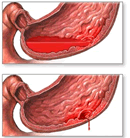Is a history of Barrett’s esophagus affecting the price you pay for life insurance?

Understanding the Esophagus and Barrett’s Esophagus
The esophagus is a muscular tube that carries food and liquid from the mouth and connects the throat to the stomach. A normal esophagus is about 12 inches long and is approximately three fourths of an inch in diameter at its smallest point. Within the walls of the esophagus are muscles that contract and push food into the stomach. It also functions to prevent stomach acid from flowing back up the esophagus. This condition is commonly referred to as gastroesophageal reflux disease (GERD).
Barrett’s esophagus is a condition in which the color and lining of cells of the esophagus change as a result of the regurgitation of stomach acid into the lower part of the esophagus. Commonly this is the consequence of the long term effects of GERD. Barrett’s esophagus is associated with an increased risk for the development of esophageal cancer.
Barrett’s esophagus can be diagnosed as a result of symptoms such as difficulty in swallowing, coughing or vomiting blood and an unexpected decrease in appetite or loss of weight. It can also be present without any apparent symptoms.
With Barrett’s esophagus, the presence and degree of change in the color of the cell tissue lining the lower esophagus is critical. To diagnose Barrett’s esophagus, an endoscopy, or scope of the upper digestive tract, is performed by a gastroenterologist. If color and cell changes are present, a biopsy, or removal of cell tissues for evaluation, is completed. The biopsy is needed to confirm the diagnosis and the severity of the condition as well as to determine the presence of dysplasia.
Dysplasia is a precancerous change in the tissue and cells of the esophagus. There are two types of dysplasia: low-grade and high-grade dysplaisia. The higher the grade of dysplasia, the greater the risk of developing cancer.
Other related medical conditions (or medical terminology) include Acid Reflux Disease, GERD, and Heartburn. Learn more information on receiving a term life insurance quote with these medical conditions from our life insurance specialists.
Barrett’s Esophagus Facts and Statistics
- There are an estimated 26 million Americans with reflux disease and 700,000 patients with Barrett’s esophagus.
- Barrett’s is now accepted as a pre-malignant condition of the esophagus.
- There is a good chance that a patient with Barrett’s esophagus will never reach the cancer stage since it normally occurs over time and there is chance to intervene.
- Although increased, the absolute risk of esophageal cancer for someone with Barrett’s esophagus is small, usually less than 1 percent a year.
- It is estimated that 90% of all patients with Barrett’s esophagus will not develop adenocarcinoma.
Risk Factors of Barrett’s Esophagus
Barrett’s esophagus can be influenced by a number of factors. Life insurance companies are especially interested in the following risk factors and how they impact each individual.
- Age. Barrett’s esophagus is normally found in individuals age 55-70.
- Chronic heartburn or gastroesophageal reflux disease (GERD).
- Gender. Men are more likely to develop this condition than women.
- Tobacco Use.
- Excessive use of alcohol.
- Occupational exposure.
- Poor diet.
By making lifestyle changes, you can eliminate or reduce the frequency of acid reflux which can minimize your chance of developing Barrett’s esophagus.
How Barrett’s Esophagus Affects Life Insurance Rates
Barrett’s esophagus is a common condition; however, insurance companies get particularly concerned when diagnosed as it can lead to the development of esophageal cancer. The good news is that it can in most cases be effectively treated with anti-reflux medications. Prilosec, Previcid and Nexium are three of the more common medications used to treat heartburn and acid reflux. Although these medications often are quite effective for GERD, they will not completely reverse Barrett’s esophagus and the risk of cancer exists even if your symptoms of GERD go away.
If you have been diagnosed with heartburn or GERD and are being successfully treated with medications and there is no formal diagnosis of Barrett’s esophagus and assuming otherwise good health, you have an excellent chance of securing life insurance at a preferred health class.
A diagnosis of Barrett’s esophagus will automatically preclude you from getting a preferred rate for life insurance.
Best case scenario, assuming a history of mild Barrett’s esophagus with successful treatment with anti-reflux medications is a standard rate for life insurance.
If Barrett’s esophagus is diagnosed and there is no dysplasia present, you may expect to pay a rate that is 50%-75% more than the standard health class. Your actual rate will depend upon the degree of color and tissue change as measured by the endoscopy.
Due to the significantly increased risk of developing esophageal cancer, if you have been diagnosed with Barrett’s esophagus with the presence of high-grade dysplasia, you are likely to be declined for life insurance.
If you have been diagnosed with Barrett’s esophagus, there are several things you can do improve your chances of getting better rates for life insurance. First, is to have regular and consistent follow up with your specialist. Good medical follow up shows that you are concerned about your condition but also provides a documented progress report of your condition. Additionally, lifestyle changes such as discontinuing the use of alcohol and tobacco as well as nutritional changes will go a long way towards securing a more competitive life insurance policy.
Additionally, keep in mind that each life insurance company will view your condition differently based on its own. Some companies will be more “open minded” when evaluating your information and will therefore offer you a lower rate for life insurance. The key is to know which insurance company will offer you the best life insurance policy based on your specific circumstances.
How Can MEG Financial Help?
At MEG Financial, we have worked with many individuals across the country that have had related histories and have helped many obtain fairly priced life insurance. A number of these clients previously attempted to buy life insurance elsewhere but were either turned down or asked to pay a significantly higher rate. Our experience helping others with related problems is invaluable to you in identifying the insurance company that will treat you most fairly.
For more specific information or to obtain a custom quote, call MEG Financial today at (877) 583-3955. You may also submit this short form and an independent insurance agent will personally contact you to go over any questions or other concerns.

 Speak with an experienced advisor!
Speak with an experienced advisor! 


